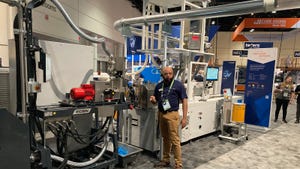Molded biocomposite combines corn cobs, peanut hulls, flax shive and recycled resin
Corn cobs, peanut hulls, and flax shive are mixed with recycled plastics for a new, greener line of injection molded plant markers. Sam McCord, CEO and founder of MCG BioComposites LLC (Cedar Rapids, IA) told PlasticsToday finished parts have biomass loadings ranging from 20-30% of the finished components, with the biofillers supplied by Best Cob (corn), CERCO (peanut hulls), and SWM International (flax shive).
August 19, 2013
Corn cobs, peanut hulls, and flax shive are mixed with recycled plastics for a new, greener line of injection molded plant markers. Sam McCord, CEO and founder of MCG BioComposites LLC (Cedar Rapids, IA) told PlasticsToday finished parts have biomass loadings ranging from 20-30% of the finished components, with the biofillers supplied by Best Cob (corn), CERCO (peanut hulls), and SWM International (flax shive).
More difficult than sourcing the biomass is securing recycled resin. "Recycled content is becoming more challenging as we grow due to higher demands," McCord noted.
Biocomposite plant markers |
Biocomposite plant marker tool |
In May 2012 MCG was awarded a grant through the State of Iowa Demonstration Fund to develop new tooling, and design and build a new web site in support of the markers, which received a Green Thumb Award through the Direct Gardening Association in 2012. The stem and the face plate of the original 9-inch marker have been widened, and the company developed an all new 13-inch marker with a 30° angled face plate for ease of view.
MCG also announced that it is working with Green Dot Holdings LLC, which purchased MGP Ingredients in Atchison, KA earlier this year. The combined company will pursue the development of new biocomposites and research additional biomass filler.
After drying, molded with ease
McCord told PlasticsToday that to support the new product, and with the help of the grant, the company built a new mold base with two separate plates and a two-cavity tool. So, how hard is it to mold a mix of corn, peanut, and flax byproducts held together with post-consumer recycled plastic? Apparently, not very, according to McCord.
"The material processes very well at 340áµ’-360áµ’F," McCord said, noting that the compound must be dried. "Parts are near net shape as warpage and shrink are very minimal due the fibers. The mold temperature averages 100áµ’F, which helps with the curing and flashing."
The markers themselves are injection molded by Anova Inc. (Dubuque, IA).
About the Author(s)
You May Also Like


